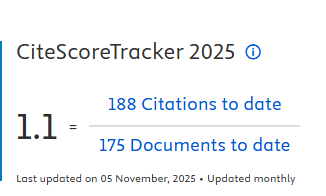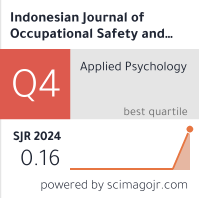Risk Assessment of Photokeratitis Among the Welders of Gamelan Gongs in Ponorogo, Indonesia

Downloads
Anastasia, H. E. and Puspita, A. (2018) ‘Faktor yang Berhubungan dengan Keluhan Konjungtivitis pada Pekerja Bengkel Las Wilayah Simpang Kawat Kota Jambi Tahun 2017', Jurnal Ilmiah Ilmu Kesehatan Wawasan Kesehatan, 5(1).
Arsanjani (2017) Faktor Yang Berhubungan Dengan Kejadian Sindrom Photokeratitis Pada Pekerja Las Listrik Di Kelurahan Romang Polong Kecamatan Somba Opu Kabupaten Gowa. Universitas Islam Negeri Alauddin. Available at: http://repositori.uin-alauddin.ac.id/8141/1/ARSANJANI.pdf.
Australia Standards/New Zealand Standards (2004) Risk Management Guideline Companion to AS/NZS 4360:2004. Sidney.
Canadian Centre for Occupational Health and Safety (CCOHS) (2016) ‘OSH Answers Fact Sheets Ultraviolet Radiation', Canadian Centre for Occupational Health and Safety (CCOHS). Available at: https://www.ccohs.ca/oshanswers/phys_agents/ultravioletradiation.html.
Canadian Centre for Occupational Health and Safety (CCOHS) (2018) ‘OSH Answers Fact Sheets Welding - Radiation and the Effects On Eyes and Skin', Canadian Centre for Occupational Health and Safety (CCOHS), 1 May. Available at: https://www.ccohs.ca/oshanswers/safety_haz/welding/eyes.html.
Cullen, A. (2002) ‘Photokeratitis and other phototoxic effects on the cornea and conjunctiva', International Journal Toxicology, 21(6), p. 455.
Firmansah, A. (2015) Analisis Faktor Yang Berhubungan Dengan Gejala Fotokeratitis Pada Pekerja Las Listrik Di Kecamatan Puger Kabupaten Jember. Universitas Jember.
Government of South Australia (2019) Welding processes: Code of Practice. Australia. Available at: https://www.safework.nsw.gov.au/__data/assets/pdf_file/0014/52160/Welding-processes-COP.pdf.
Harahap, P., Rachman, I. and Simanjuntak, F. (2018) ‘Faktor-Faktor yang Berhubungan dengan Keluhan Mata pada Pekerja Las Industri Kecil di Kecamatan Tungkal Ilir Kabupaten Tanjab Barat Tahun 2017', Jurnal Sekolah Tinggi Ilmu Kesehatan Harapan Ibu Jambi, 5(1).
Harris, P. M. (2011) ‘Workplace Injuries Involving the Eyes, 2008', U.S. Bureau of Labor Statistics. Available at: https://www.bls.gov/opub/mlr/cwc/workplace-injuries-involving-the-eyes-2008.pdf.
Ho, C.-K. et al. (2007) ‘Epidemiologic Study on Work-related Eye Injuries in Kaohsiung, Taiwan', The Kaohsiung journal of medical sciences, 23, pp. 463–469. doi: 10.1016/S1607-551X(08)70054-8.
Indonesian Central Statistics Agency (2018) Labor Force Situation in Indonesia August 2018. Jakarta. Available at: https://www.bps.go.id/publication/2018/11/30/6d8a8eb26ac657f7bd170fca/keadaan-angkatan-kerja-di-indonesia-agustus-2018.html.
International Commission on Non-Ionizing Radiation Protection (ICNIRP) (2007) Protecting Workers from Ultraviolet Radiation. Paolo Vecc, International Commission on Non-Ionizing Radiation Protection International Labour Organization World Health Organization. Paolo Vecc.
Joseph, N. et al. (2017) ‘Occupation Hazards - Pattern, Awareness and Preventive Measures among Welders from an Unorganized Sector in India', Journal of clinical and diagnostic research : JCDR. 2017/05/01, 11(5), pp. LC23–LC28. doi: 10.7860/JCDR/2017/24977.9879.
Kumah, D. Ben et al. (2015) ‘Prevalence of allergic conjunctivitis among basic school children in the Kumasi Metropolis (Ghana): A community-based cross-sectional study', BMC Ophthalmology, 15(1), pp. 1–5. doi: 10.1186/s12886-015-0053-8.
Kuo, Y.-K. et al. (2019) ‘Dry Eye Disease: A Review of Epidemiology in Taiwan, and its Clinical Treatment and Merits.', Journal of clinical medicine, 8(8). doi: 10.3390/jcm8081227.
Kurniawan, A. (2017) ‘Gejala fotokeratitis akut akibat radiasi sinar ultraviolet (UV) pada pekerja las di PT. PAL Indonesia Surabaya', Jurnal Ilmu Kesehatan Masyarakat, 13(1), pp. 22–31. doi: https://doi.org/10.19184/ikesma.v13i1.7021.
Laila, N. . (2017) ‘Keluhan Subjektif Photokeratitis Pada Mata Pekerja Las Sektor Informal Di Kelurahan Cirendeu Dan Ciputat Tangerang Selatan. Jurnal: UIN Syarif Hidayatullah Jakarta', in Prosiding Seminar Nasional IKAKESMADA "Peran Tenaga Kesehatan dalam Pelaksanaan SDGs”, pp. 199–204. Available at: http://eprints.uad.ac.id/id/eprint/5396.
Law of the Republic of Indonesia (2003) Law of the Republic of Indonesia No. 13 of 2003 Concerning Employment, Indonesia.
Law of the Republic of Indonesia (2009) Law of the Republic of Indonesia No. 36 of 2009 Concerning Health, Law of the Republic of Indonesia. Available at: http://downloads.esri.com/archydro/archydro/Doc/Overview of Arc Hydro terrain preprocessing workflows.pdf%0Ahttps://doi.org/10.1016/j.jhydrol.2017.11.003%0Ahttp://sites.tufts.edu/gis/files/2013/11/Watershed-and-Drainage-Delineation-by-Pour-Point.pdf%0Awww.
Lenikov, A. (2012) ‘Perbaikan dari photokeratitis ultraviolet-induced pada tikus yang diobati', Molecular Vision, pp. 455–464.
Maryam, R. S. (2008) Mengenal Usia Lanjut dan Perawatannya. Jakarta: Salemba Medika.
McIntosh, S. E. et al. (2011) ‘Ultraviolet keratitis among mountaineers and outdoor recreationalists.', Wilderness & environmental medicine, 22(2), pp. 144–147. doi: 10.1016/j.wem.2011.01.002.
Minister of Manpower Regulation (2018) Minister of Manpower of the Republic of Indonesia number 5 of 2018 concerning Occupational Safety and Health. Jakarta: Minister of Manpower and Transmigration Republic of Indonesia.
Ministry of Health of the Republic of Indonesia (2013) The main points of Indonesia's basic health research results 2013.
Minton, J. (1946) ‘Occupational Eye Diseases', British medical journal, 1(4440), pp. 211–212. Available at: https://pubmed.ncbi.nlm.nih.gov/20786551.
Modenese, L. et al. (2018) ‘Investigation of the dependence of joint contact forces on musculotendon parameters using a codified workflow for image-based modelling.', Journal of biomechanics, 73, pp. 108–118. doi: 10.1016/j.jbiomech.2018.03.039.
Moore, L. A. et al. (2010) ‘Review of photokeratitis: Corneal response to ultraviolet radiation (UVR) exposure*', African Vision and Eye Health, 69(3), pp. 123–131. doi: 10.4102/aveh.v69i3.137.
Nurgazali (2016) Gambaran Faktor risiko Sindrom Photokeratitis pada Pekerja Las di PT. Industri Kapal Indonesia (Persero) Kota Makassar. UIN Alauddin Makassar.
Olishifski, J. . (1985) Fundamental of Industrial Hygiene. Washington DC: National Safety Council.
Pratiwi, Y. S., Widada, W. and A, Z. E. Y. (2015) ‘No Title', The Indonesian Journal of Health Science, 5(2), pp. 137–149. doi: https://doi.org/10.32528/the.v5i2.2.
Priyadi, R. (2017) Pemetaan Potensi Pembentukan Pos Upaya Kesehatan Kerja Terintegrasi di Wilayah Puskesmas Jurang Mangu Kota Tangerang Selatan tahun 2017. Universitas Islam Negeri Syarif Hidayatullah Jakarta. Available at: https://repository.uinjkt.ac.id/dspace/bitstream/123456789/36638/1/Ruditho Priyandi-FKIK.pdf.
Qolik, A. et al. (2018) ‘Bahaya Asap dan Radiasi Sinar Las Terhadap Pekerja Las di Sektor Informal', Jurnal Tek Mesin dan Pembelajaran, 1(1), p. 1.
Ramli, S. (2010) Sistem Manajemen Keselamatan dan Kesehatan Kerja. Jakarta: Dian Rakyat.
Rizwaningrum, M. (2012) Hubungan perilaku pemakaian alat pelindung mata dengan keluhan subjektif mata pada pekerja bengkel las konstruksi di wilayah kerja puskesmas Ambacang tahun 2012. Universitas Andalas.
Rokom (2016) ‘Hidupkan Pos UKK Agar Pekerja Sektor Informal Tersentuh Layanan Kesehatan Kerja', Ministry of Health of the Republic of Indonesia, 8 November. Available at: https://sehatnegeriku.kemkes.go.id/baca/rilis-media/20161108/1518810/hidupkan-pos-ukk-agar-pekerja-sektor-informal-tersentuh-layanan-kesehatan-kerja/.
Setia, M. A., Setyaningsih, Y. and Mifbakhuddin (2007) ‘difference Trouble Eyesight Effect Radiasi Pursuant to Habit Usage Eyeglasses Las and Characteristic Informal Worker Las Sector', Jurnal Fakultas Kesehatan Masyarakat Universitas Muhammadyah Semarang. Available at: http://digilib.unimus.ac.id/files/disk1/10/jtptunimus-gdl-s1-2008-manissetia-477-1-abstrak.pdf.
Siswanto, A. (1994) Bahaya Las. Balai Hiperkes dan Keselamatan Kerja Jawa Timur Departemen Tenaga Kerja.
Suherni, S. et al. (2021) ‘Determinan Keluhan Konjungtivitis Pada Pekerja Las Di Kecamatan Jelutung Kota Jambi', Jurnal Kesmas Jambi, 5(1), pp. 21–27. doi: 10.22437/jkmj.v5i1.12398.
Suma'mur (2009) Higiene Perusahaan dan Kesehatan Kerja. Jakarta: CV Haji Masagung.
Suma'mur (2014) Corporate Hygiene and Occupational Health Issue 2. Jakarta: Sagung Seto.
Susanto (2014) Faktor Yang Berhubungan Dengan Keluhan Photokeratokonjungtifis pada Operator Las Di Bengkel Las KecamatanBiringkanaya Kota Makassar Tahun 2014. Universitas Hasanuddin.
Tenkate, T. D. and Collins, M. J. (1997) ‘Personal ultraviolet radiation exposure of workers in a welding environment.', American Industrial Hygiene Association journal, 58(1), pp. 33–38. doi: 10.1080/15428119791013053.
The University of Adelaide (2016) Risk Management Legal and Risk handbook. Australia. Available at: https://www.adelaide.edu.au/legalandrisk/system/files/media/documents/2019-04/Risk Management Handbook - April 2019.pdf.
United States Departement Of Labor (2015) Eye and Face Protection, OSHA News Release. Available at: https://www.osha.gov/eye-face-protection (Accessed: 3 November 2021).
Wahyuni, S. (2012) Keluhan subjektif photokeratitis pada tukang las di jalan bogor, Bandung tahun 2012. Universitas Indonesia.
Watson, S., Cabrera-Aguas, M. and Khoo, P. (2018) ‘Common eye infections', Australian Prescriber, 41(3), pp. 67–72. doi: 10.18773/austprescr.2018.016.
White, J. . (2017) Eye Injury Statistics. Available at: https://www.jjwhiteinc.com/2017/08/09/eye-injury-statistics/.
Willmann, D., Fu, L. and Melanson, S. (2021) Corneal Injury. In: StatPearls (Internet). Treasure Island (FL): StatPearls Publishing. Available at: https://www.ncbi.nlm.nih.gov/books/NBK459283/.
Wiryosumarto, H. and Okumura, T. (2014) Teknologi Pengelasan Logam. Jakarta: Balai Pustaka.
Zahrah, A., Nataliningrum, D. and Harihardjaja, W. (2018) ‘Correlation Between The Use Of Personal Protective Equipment, Distance From The Welding Arc, And Intensity Of The Radiation With Subjective Symptoms Of Photokeratitis', Jurnal Fakultas Kedokteran Universitas Jenderal Achmad Yani.
Copyright (c) 2023 The Indonesian Journal Of Occupational Safety and Health

This work is licensed under a Creative Commons Attribution-NonCommercial-ShareAlike 4.0 International License.

In order to be accepted and published by The Indonesian Journal of Occupational Safety and Health, Author(s) who submit an article should complete all the review process. The copyright of received articles assigned to the The Indonesian Journal of Occupational Safety and Health and Department of Safety and Health, Universitas Airlangga as publishers of the journal. The intended copyright includes the rights to publish articles in various forms (including reprints).
The Editorial Team of The Indonesian Journal Of Occupational Safety and Health and Department of Safety and Health strive to ensure that no errors occur in the articles that have been published, both data errors and statements in the article.
Users of this website will be licensed to use materials from this website following the Creative Commons Attribution-NonCommercial-ShareAlike 4.0 International License. No fees charged. Please use the materials accordingly.
------------------------------------------------------------------------------------------------------------------------------------------------------------------------------------------
Attribution ” You must give appropriate credit, provide a link to the license, and indicate if changes were made. You may do so in any reasonable manner, but not in any way that suggests the licensor endorses you or your use.
NonCommercial ” You may not use the material for commercial purposes.
ShareAlike ” If you remix, transform, or build upon the material, you must distribute your contributions under the same license as the original.







 How to Submit Articles in OJS
How to Submit Articles in OJS

























